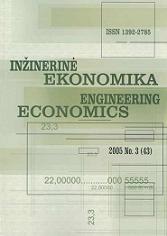Cost-Benefit Analysis in Public Project Appraisal
Cost-Benefit Analysis in Public Project Appraisal
Author(s): Krystyna BrzozowskaSubject(s): Economy
Published by: Kauno Technologijos Universitetas
Keywords: appraisal; public project; Cost Benefit Analysis; discount rate; public choice.
Summary/Abstract: The main problem in the most public projects appraisal is their uneconomic nature and impossibility to measure such data, like as turnover and current costs, necessary for NPV or IRR calculation. An appraisal of economic effi-ciency, as a measure of the net contribution of a project to overall social welfare, should be conducted to each single case. Standard appraisal methods based on projected profits and investment expenditures are not applicable because of intangible nature of pure public projects. In such cases Cost – Benefit Analysis (CBA) has been applied. The purpose of CBA is to ensure that the public sector allocates scarce re-sources efficiently to competing public sector projects. A basic assumptions of CBA is an identification the crucial benefits effected from a project and their valuation to con-duct project appraisal in terms of its effectiveness. A mixture of benefits and costs will be differentiated, because of pro-ject purpose and designing. The cost of a project should be somehow related to the benefit expected from it. The rule that has evolved over many years is that benefits must ex-ceed the costs from a project. CBA estimates and totals up the equivalent money value of the benefits and costs to the community of projects to establish whether they are worth-while. This means that all benefits and costs of a project should be measured in terms of their equivalent money value and in particular time. The most useful financial results in a CBA appear in a time-based cash flow summary. The basic rule of CBA is that project should be performed only then, when dis-counted benefits would be higher than discounted invest-ment expenditures. As the investment expenditures are treated exact cost of investment and operation costs after project putting into life. After some years of CBA exercising such analysis has still prompted some doubts connected mainly to choice of appropriate discount rate, externalities, risk and irre-versibility. Their override is a subject of research of many economists. Despite of critical remarks and some simplifications CBA has still been treated as a simple tool with numerous applications in various spheres, especially in environmental and other pure public projects, used commonly by banks and investors, more rarely by state agendas and local governments – especially in less de-veloped countries. The aim of a paper is to present problems and con-troversies with Cost–Benefit Analysis application to pub-lic project appraisal. The paper consists of five parts, in which there are distinguished public goods, key assump-tions to public project appraisal, the main rules of Cost-Benefit Analysis, discount rate issues, and a background of project choice.
Journal: Engineering Economics
- Issue Year: 2007
- Issue No: 3 (53)
- Page Range: 78-83
- Page Count: 6
- Language: English

